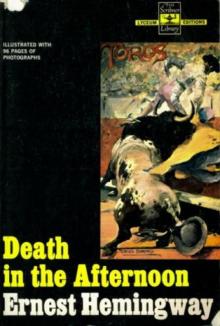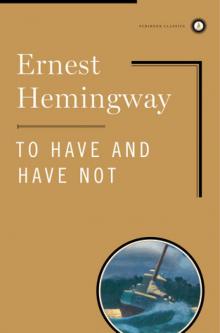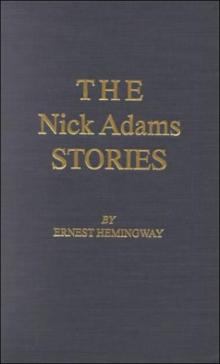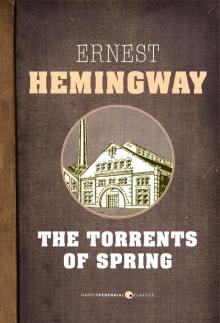- Home
- Ernest Hemingway
The Nick Adams Stories
The Nick Adams Stories Read online
THE Nick Adams STORIES
By
ERNEST HEMINGWAY
PREFACE BY PHILIP YOUNG
SCRIBNER
New York London Toronto Sydney
1972 The Ernest Hemingway Foundation
1972 Charles Scribner’s Sons
1969 Mary Hemingway
1933 Charles Scribner’s Sons;
1961 Mary Hemingway
1925 Charles Scribner’s Sons;
1953 Ernest Hemingway
1927 Charles Scribner’s Sons;
1955
1927 Charles Scribner’s Sons;
1955 Ernest Hemingway
1927 Macaulay Company
1955 Ernest Hemingway
First Scribner trade paperback edition 2003
THE NICK ADAMS STORIES
BOOKS BY ERNEST HEMINGWAY
NOVELS
The Torrents of Spring
The Sun Also Rises
A Farewell to Arms
To Have and Have Not
For Whom the Bell Tolls
Across the River and Into the Trees
The Old Man and the Sea
Islands in the Stream
The Garden of Eden
True at First Light
A Farewell to Arms: The Hemingway Library Edition
STORIES
In Our Time
Men Without Women
Winner Take Nothing
The Fifth Column and Four Stories of the Spanish Civil War
The Short Stories of Ernest Hemingway
The Snows of Kilimanjaro and Other Stories
The Nick Adams Stories
The Complete Short Stories of Ernest Hemingway
NONFICTION
Death in the Afternoon
Green Hills of Africa
Selected Letters 1917-1961
A Moveable Feast
The Dangerous Summer
Dateline: Toronto
By-Line: Ernest Hemingway
A Moveable Feast: The Restored Edition
ANTHOLOGIES
On Writing
Hemingway on Fishing
Hemingway on Hunting
Hemingway on War
SCRIBNER
1230 Avenue of the Americas
NewYork, NY 10020
www.SimonandSchuster.com
This book is a work of fiction. Names, characters, places, and incidents either are products of the author’s imagination or are used fictitiously. Any resemblance to actual events or locales or persons, living ordead, is entirely coincidental.
Copyright © 1972 The Ernest Hemingway Foundation
Preface by Philip Young
Copyright © 1972 Charles Scribner’s Sons
Copyright © 1969 Mary Hemingway
Copyright 1933 Charles Scribner’s Sons; renewal copyright © 1961 Mary Hemingway
Copyright 1925 Charles Scribner’s Sons; renewal copyright © 1953 Ernest Hemingway
Copyright 1927 Charles Scribner’s Sons; renewal copyright © 1955
Copyright 1927 Charles Scribner’s Sons; renewal copyright © 1955 Ernest Hemingway
Copyright 1927 Macaulay Company; renewal copyright © 1955 Ernest Hemingway
Publication of the eight previously unpublished pieces in this book is the result of a gift of the English-language rights by Mary Hemingway to The Ernest Hemingway Foundation.
All rights reserved, including the right of reproduction in whole or in part in any form.
First Scribner trade paperback edition 2003
SCRIBNER and design are trademarks of Macmillan Library Reference USA, Inc., used under license by Simon & Schuster, the publisher of this work.
For information about special discounts for bulk purchases, please contact Simon & Schuster Special Sales: 1-800-456-6798 or [email protected]
Manufactured in the United States of America
37 39 40 38 36
Library of Congress Catalog Card Number 77-159759
ISBN-13: 978-0-684-16940-8
eISBN-13: 978-1-4391-8842-2
ISBN-10: 0-684-16940-1
Half-title page decoration by Walter Ferro
PREFACE
“Of the place where he had been a boy he had written well enough. As well as he could then.” So thought a dying writer in an early version of “The Snows of Kilimanjaro.” The writer of course was Hemingway. The place was the Michigan of his boyhood summers, where he remembered himself as Nick Adams. As well as he could write then was very well indeed.
Until now, however, the stories involving Nick have always appeared so many to a book, in jumbled sequence. As a result the coherence of his adventures has been obscured, and their impact fragmented. In Men Without Women, Hemingway’s second collection of stories, Nick appears first as a soldier in Italy, next as an adolescent in Summit, Illinois, then in turn as a younger boy in Michigan, a married man in Austria, and a soldier back in Italy. Or consider the trouble with “Big Two-Hearted River,” one of the best-known Hemingway stories. Placed where it was—at the end of In Our Time, the first collection—it puzzled a good many readers. Put where it goes chronologically, following the stories of World War I, its submerged tensions—the impression that Nick is exorcising some nameless anxiety—become perfectly understandable. But “A Way You’ll Never Be,” which precedes “Big Two-Hearted River” in time and explains it, was published eight years and several books after it.
Arranged in chronological sequence, the events of Nick’s life make up a meaningful narrative in which a memorable character grows from child to adolescent to soldier, veteran, writer, and parent—a sequence closely paralleling the events of Hemingway’s own life. In this arrangement Nick Adams, who for a long time was not widely recognized as a consistent character at all, emerges clearly as the first in a long line of Hemingway’s fictional selves. Later versions, from Jake Barnes and Frederic Henry to Richard Cantwell and Thomas Hudson, were all to have behind them part of Nick’s history and, correspondingly, part of Hemingway’s.
As is true for many writers of fiction, the relationship between Hemingway’s work and the events of his own life is an immediate and intricate one. In some stories he appears to report details of actual experience as faithfully as he might have entered them in a diary. In others the play of his imagination has transformed experience into a new and different reality. Exploring the connections between actuality and fiction in Hemingway can be an absorbing activity, and readers who wish to pursue it are referred to the biographical studies listed at the end of this preface. But Hemingway naturally intended his stories to be understood and enjoyed without regard for such considerations—as they have been for a long time.
The first Nick Adams fiction appeared almost a half-century ago, the last in 1933, and over the years a great deal has been written about it. Among the unpublished manuscripts Hemingway left behind him, however, eight new contributions to the over-all narrative were discovered. Presented here for the first time, inserted in the places in time where the events fall, they are varied in length and apparent purpose. Three accounts—of how the Indians left the country of Nick’s boyhood, of his first sight of the Mississippi, and of what happened just before and after his wedding—are quite brief. If the author had larger plans for any of them, such are unknown; they might be read simply as sketches in an artist’s notebook. In two other cases his plans are self-evident, for here we have the beginnings of works that were never completed. Nick on board the Chicago, bound for France during World War I, was the start of a novel called Along with Youth that was abandoned long ago. Similarly, though much later, the plot of “The Last Good Country” was left in mid-air, and many pages would have been required to resolve it. Two other pieces are known to have originated
in Nick stories already published. “Three Shots” tells how the young boy became frightened while on a camping trip. It once preceded the story called “Indian Camp.” And Nick’s “stream of consciousness” reflections on his writing career once (anachronistically) concluded “Big Two-Hearted River.” Of these new works only “Summer People,” very likely the first fiction Hemingway wrote about Nick Adams, can be regarded as a full-length, completed story.
To distinguish them from previously published works, all the new materials in this book have been printed in a special “oblique” type. If the decision to publish them at all is questioned, justification is available. For one thing, the plan for rearranging the Nick Adams stories coherently benefits from material that fills substantial gaps in the narrative. Further, all this new fiction relates in one way or another to events in the author’s life, in which his readers continue to be interested. Last and most important is the fact that these pieces throw new light on the work and personality of one of our foremost writers and genuinely increase our understanding of him. The typography suggests an oblique introduction, but a warm reception is expected.
—PHILIPYOUNG
BIOGRAPHICAL STUDIES
BAKER, CARLOS. Ernest Hemingway: A Life Story. New York: Charles Scribner’s Sons, 1969.
HEMINGWAY, LEICESTER. My Brother, Ernest Hemingway. New York: World Publishing Company,1962.
MONTGOMERY, CONSTANCE CAPPEL. Hemingway in Michigan. New York: Fleet Press Corporation,1966.
SANFORD, MARCELLINE HEMINGWAY. At the Hemingways: A Family Portrait. Boston: Little, Brown and Company, 1962.
CONTENTS
PREFACE
I THE NORTHERN WOODS
Three Shots
Indian Camp
The Doctor and the Doctor’s Wife
Ten Indians
The Indians Moved Away
II ON HIS OWN
The Light of the World
The Battler
The Killers
The Last Good Country
Crossing the Mississippi
III WAR
Night Before Landing
“Nick sat against the wall…”
Now I Lay Me
A Way You’ll Never Be
In Another Country
IV A SOLDIER HOME
Big Two-Hearted River
The End of Something
The Three-Day Blow
Summer People
V COMPANY OF TWO
Wedding Day
On Writing
An Alpine Idyll
Cross-Country Snow
Fathers and Sons
I THE NORTHERN WOODS
Three Shots
Nick was undressing in the tent. He saw the shadows of his father and Uncle George cast by the fire on the canvas wall. He felt very uncomfortable and ashamed and undressed as fast as he could, piling his clothes neatly. He was ashamed because undressing reminded him of the night before. He had kept it out of his mind all day.
His father and uncle had gone off across the lake after supper to fish with a jack light. Before they shoved the boat out his father told him that if any emergency came up while they were gone he was to fire three shots with the rifle and they would come right back. Nick went back from the edge of the lake through the woods to the camp. He could hear the oars of the boat in the dark. His father was rowing and his uncle was sitting in the stern trolling. He had taken his seat with his rod ready when his father shoved the boat out. Nick listened to them on the lake until he could no longer hear the oars.
Walking back through the woods Nick began to be frightened. He was always a little frightened of the woods at night. He opened the flap of the tent and undressed and lay very quietly between the blankets in the dark. The fire was burned down to a bed of coals outside. Nick lay still and tried to go to sleep. There was no noise anywhere. Nick felt if he could only hear a fox bark or an owl or anything he would be all right. He was not afraid of anything definite as yet. But he was getting very afraid. Then suddenly he was afraid of dying. Just a few weeks before at home, in church, they had sung a hymn, “Some day the silver cord will break.” While they were singing the hymn Nick had realized that some day he must die. it made him feel quite sick, it was the first time he had ever realized that he himself would have to die sometime.
That night he sat out in the hall under the night light trying to read Robinson Crusoe to keep his mind off the fact that some day the silver cord must break. The nurse found him there and threatened to tell his father on him if he did not go to bed. He went in to bed and as soon as the nurse was in her room came out again and read under the hall light until morning.
Last night in the tent he had had the same fear. He never had it except at night. It was more a realization than a fear at first. But it was always on the edge of fear and became fear very quickly when it started. As soon as he began to be really frightened he took the rifle and poked the muzzle out the front of the tent and shot three times. The rifle kicked badly. He heard the shots rip off through the trees. As soon as he had fired the shots it was all right.
He lay down to wait for his father’s return and was asleep before his father and uncle had put out their jack light on the other side of the lake.
“Damn that kid,” Uncle George said as they rowed back. “What did you tell him to call us in for? He’s probably got the heebie-jeebies about something.”
Uncle George was an enthusiastic fisherman and his father’s younger brother.
“Oh, well. He’s pretty small,” his father said.
“That’s no reason to bring him into the woods with us.”
“I know he’s an awful coward,” his father said, “but we’re all yellow at that age.”
“I can’t stand him,” George said. “He’s such an awful liar.”
“Oh, well, forget it. You’ll get plenty of fishing anyway.”
They came into the tent and Uncle George shone his flashlight into Nick’s eyes.
“What was it, Nickie?” said his father. Nick sat up in bed.
“it sounded like a cross between a fox and a wolf and it was fooling around the tent,” Nick said, “it was a little like a fox but more like a wolf.” He had learned the phrase “cross between” that same day from his uncle.
“He probably heard a screech owl,” Uncle George said.
In the morning his father found two big basswood trees that leaned across each other so that they rubbed together in the wind.
“Do you think that was what it was, Nick?” his father asked.
“Maybe,” Nick said. He didn’t want to think about it.
“You don’t want to ever be frightened in the woods, Nick. There is nothing that can hurt you.”
“Not even lightning?” Nick asked.
“No, not even lightning. If there is a thunder storm get out into the open. Or get under a beech tree. They’re never struck.”
“Never?” Nick asked.
“I never heard of one,” said his father.
“Gee, I’m glad to know that about beech trees,” Nick said.
Now he was undressing again in the tent. He was conscious of the two shadows on the wall although he was not watching them. Then he heard a boat being pulled up on the beach and the two shadows were gone. He heard his father talking with someone.
Then his father shouted, “Get your clothes on, Nick.”
He dressed as fast as he could. His father came in and rummaged through the duffel bags.
“Put your coat on, Nick,” his father said.
Indian Camp
At the lake shore there was another rowboat drawn up. The two Indians stood waiting.
Nick and his father got in the stern of the boat and the Indians shoved it off and one of them got in to row. Uncle George sat in the stern of the camp rowboat. The young Indian shoved the camp boat off and got in to row Uncle George.
The two boats started off in the dark. Nick heard the oarlocks of the other boat quite a way ahead of them in the mist.
The Indians rowed with quick choppy strokes. Nick lay back with his father’s arm around him. It was cold on the water. The Indian who was rowing them was working very hard, but the other boat moved farther ahead in the mist all the time.
“Where are we going, Dad?” Nick asked.
“Over to the Indian camp. There is an Indian lady very sick.”
“Oh,” said Nick.
Across the bay they found the other boat beached. Uncle George was smoking a cigar in the dark. The young Indian pulled the boat way up the beach. Uncle George gave both the Indians cigars.
They walked up from the beach through a meadow that was soaking wet with dew, following the young Indian who carried a lantern. Then they went into the woods and followed a trail that led to the logging road that ran back into the hills. It was much lighter on the logging road as the timber was cut away on both sides. The young Indian stopped and blew out his lantern and they all walked on along the road.
They came around a bend and a dog came out barking. Ahead were the lights of the shanties where the Indian bark-peelers lived. More dogs rushed out at them. The two Indians sent them back to the shanties. In the shanty nearest the road there was a light in the window. An old woman stood in the doorway holding a lamp.
Inside on a wooden bunk lay a young Indian woman. She had been trying to have her baby for two days. All the old women in the camp had been helping her. The men had moved off up the road to sit in the dark and smoke out of range of the noise she made. She screamed just as Nick and the two Indians followed his father and Uncle George into the shanty. She lay in the lower bunk, very big under a quilt. Her head was turned to one side. In the upper bunk was her husband. He had cut his foot very badly with an ax three days before. He was smoking a pipe. The room smelled very bad.
Nick’s father ordered some water to be put on the stove, and while it was heating he spoke to Nick.
“This lady is going to have a baby, Nick,” he said.
“I know,” said Nick.
“You don’t know,” said his father. “Listen to me. What she is going through is called being in labor. The baby wants to be born and she wants it to be born. All her muscles are trying to get the baby born. That is what is happening when she screams.”

 The Old Man and the Sea
The Old Man and the Sea Green Hills of Africa
Green Hills of Africa The Sun Also Rises
The Sun Also Rises Death in the Afternoon
Death in the Afternoon In Our Time
In Our Time For Whom the Bell Tolls
For Whom the Bell Tolls A Farewell to Arms
A Farewell to Arms A Moveable Feast
A Moveable Feast The Complete Short Stories of Ernest Hemingway
The Complete Short Stories of Ernest Hemingway Big Two-Hearted River
Big Two-Hearted River Winner Take Nothing
Winner Take Nothing Islands in the Stream
Islands in the Stream To Have and Have Not
To Have and Have Not The Snows of Kilimanjaro and Other Stories
The Snows of Kilimanjaro and Other Stories Across the River and Into the Trees
Across the River and Into the Trees By-Line Ernest Hemingway
By-Line Ernest Hemingway True at First Light
True at First Light Men Without Women
Men Without Women The Nick Adams Stories
The Nick Adams Stories Dateline- Toronto
Dateline- Toronto The Torrents of Spring
The Torrents of Spring Short Stories
Short Stories